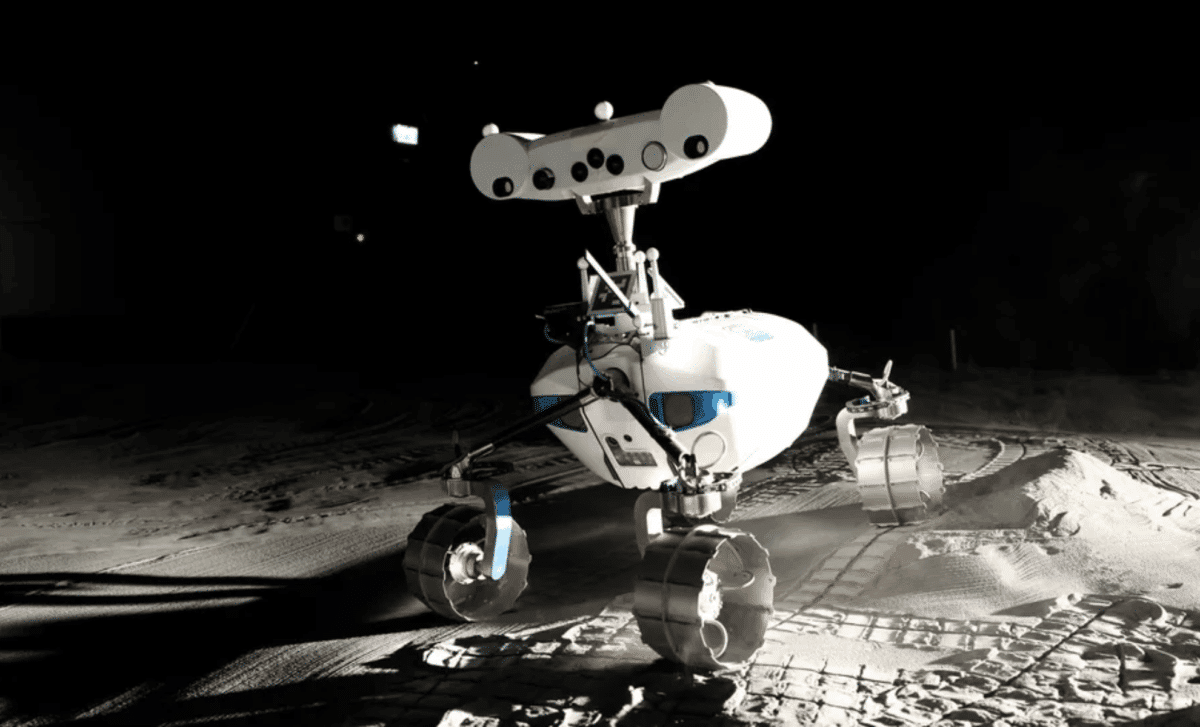In an innovative simulation, two rovers from DLR (the German space agency) have been tasked with finding a critical resource on the Moon: water ice. Using advanced technology, including cameras and lasers, these rovers are testing methods that could assist future Artemis missions in locating essential water supplies on the lunar surface. The success of this test could change how we approach lunar exploration.
The Technology Behind DLR’s Rovers: A Blend of Innovation and Necessity
Exploring the Moon’s surface is no easy feat, especially when the goal is to locate something as elusive as water ice. For DLR, developing the right tools for this task is paramount to ensuring future astronauts can live and work on the Moon without relying entirely on Earth for supplies. One of the key technologies being tested is the combination of high-tech cameras and ground-penetrating radar.
The rover LRU1, resembling WALL-E, is equipped with a panoramic camera capable of seeing both within the visible spectrum and beyond it. This dual-vision allows it to identify minerals and ice buried beneath the surface, which is essential for locating water ice in future lunar missions. The rover also carries a trailer with ground-penetrating radar, which can “see” what lies beneath the Moon’s surface—giving a complete picture of the terrain.
Meanwhile, LRU2 operates as the rover’s assistant, using a laser-equipped arm to conduct spectroscopy on rocks. This technique analyzes light patterns emitted from the rocks, helping scientists identify the chemical composition of the surface. By focusing on promising boulders, the rover can pinpoint areas where water might be hiding.
“The combination of different methods offers advantages in learning about the surface and what lies below,” said Nicole Schmitz, a planetary scientist at the DLR Institute of Space Research.
This variety of tools could prove crucial when the rovers are eventually sent to the Moon for real.
 Two rovers from DLR, known as LRU2 (left) and LRU1 (right), hunt for water in a simulated lunar environment in Cologne, Germany. (Image credit: DLR (CC BY-NC-ND 3.0))
Two rovers from DLR, known as LRU2 (left) and LRU1 (right), hunt for water in a simulated lunar environment in Cologne, Germany. (Image credit: DLR (CC BY-NC-ND 3.0))
Why Water Ice on the Moon Is So Important for Future Missions
Water on the Moon isn’t just a scientific curiosity; it’s a critical resource for future lunar missions. For astronauts heading to the Moon, bringing water from Earth would be costly and inefficient. However, if lunar water ice can be found and harvested, it could support long-term missions by providing drinking water, oxygen, and even rocket fuel.
The DLR’s test mission at the Luna Analog Facility in Cologne, Germany, is helping to solve this problem. The rovers’ search for water ice is part of a broader effort to identify areas on the Moon that contain enough water to support sustained human presence. This technology is crucial for ensuring that missions like NASA’s Artemis can rely less on Earth supplies and more on what’s available on the Moon.
Moreover, water ice on the Moon is not just useful for life support—it can also help in creating fuel for spacecraft. Water can be broken down into hydrogen and oxygen, which are key components of rocket fuel. By identifying where water ice is buried, astronauts could potentially refuel rockets for deep space missions, reducing the need for fuel supplies launched from Earth.
Overcoming Challenges: How DLR’s Rovers Are Tested in Extreme Conditions
Simulating the harsh conditions of the Moon is no easy task. The DLR rovers are tested in a facility designed to replicate the lunar environment, with challenges like rough terrain, deep regolith, and extreme temperatures. These conditions make it necessary for the rovers to be highly adaptable and capable of navigating difficult landscapes.
One of the most challenging aspects of the test mission involved detecting water beneath a mock lava cave. Using seismic cables and artificial “moonquakes,” the rovers were able to detect water deep beneath the surface. This method could one day be used on the Moon, where natural seismic activity may give clues about hidden water deposits.
According to DLR, “this mission, which was the first prove-out of the tech provided by several participating entities, showed all the elements are working.”
With this promising result, scientists are now focused on refining the technology for future lunar exploration missions.

